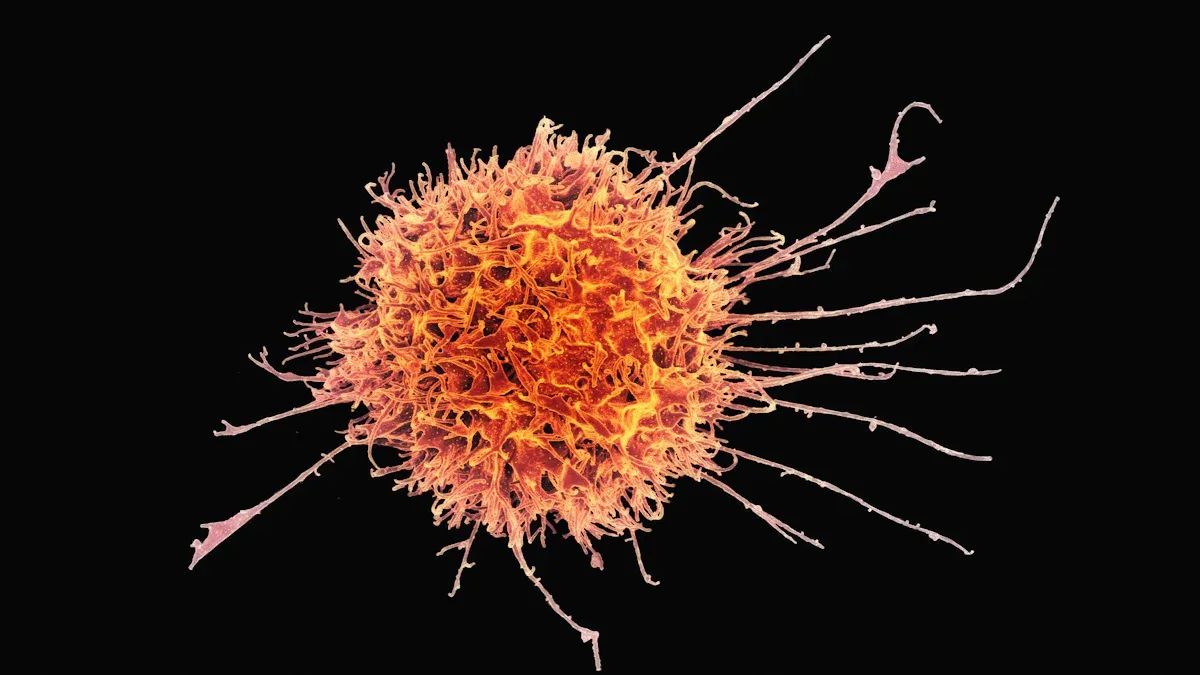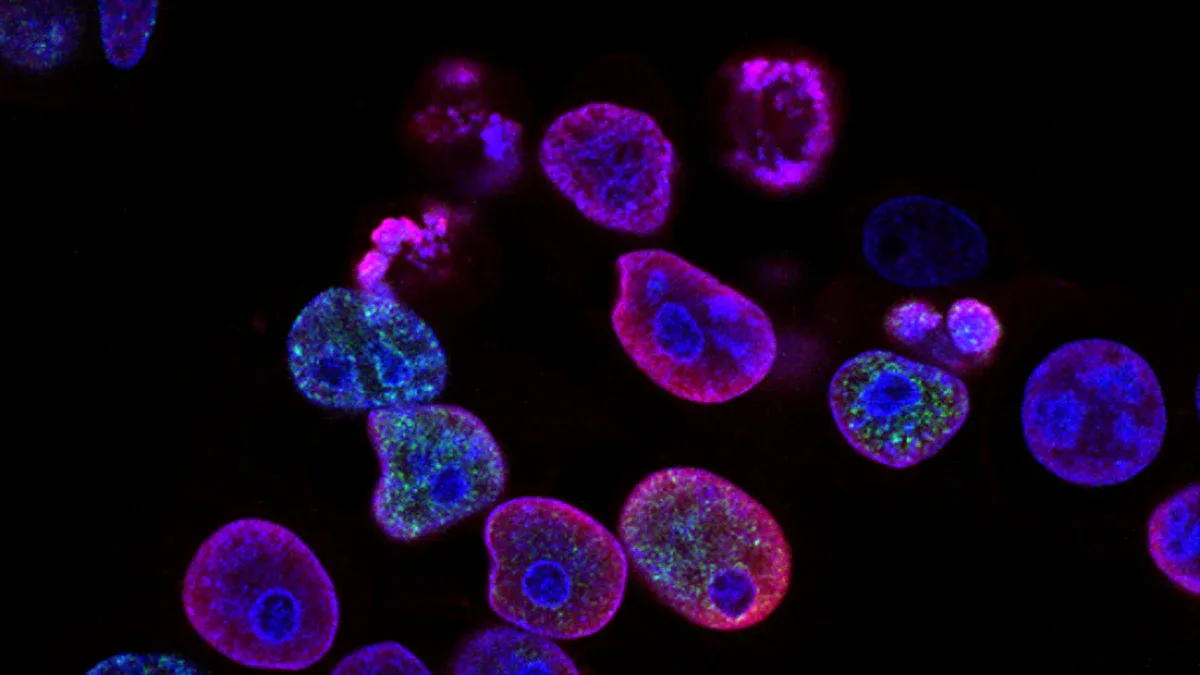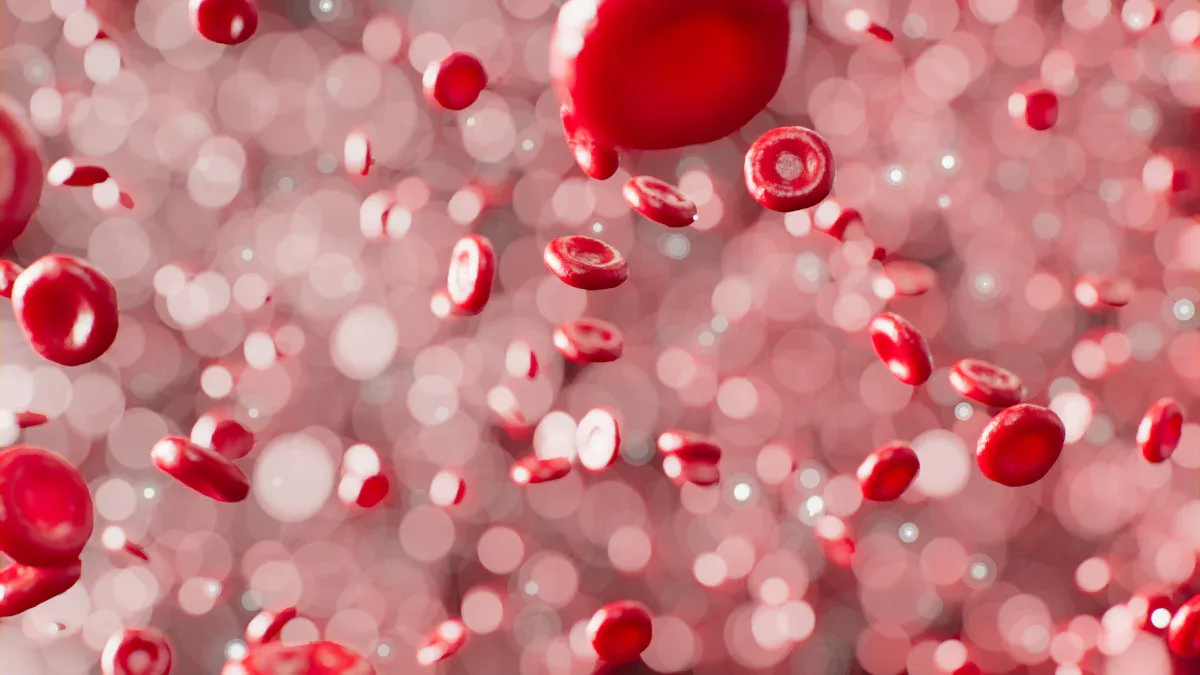What Is Acute Myeloid Leukemia? Simple Explanation

Acute myeloid leukemia is a rare but aggressive cancer that affects your blood and bone marrow. It occurs when abnormal blood cells grow uncontrollably, disrupting the production of healthy cells. Globally, the number of cases rose from 79,372 in 1990 to 144,645 in 2021, with higher rates in developed countries. This rapid progression makes early detection critical. You should know that AML can impact anyone, but it disproportionately affects older adults and men. Understanding this disease can help you recognize its urgency and seek timely medical care.
Key Takeaways
Acute myeloid leukemia (AML) is a fast-spreading cancer of blood and bone marrow.
It can cause problems like tiredness, easy bruising, and many infections.
Knowing these signs helps find and treat AML early.
Things like age, gender, smoking, and chemical exposure increase AML risk.
Changes in genes also affect how AML starts and is treated.
Finding AML early and starting treatment can save lives, especially in younger people.
What Is Acute Myeloid Leukemia?
A Cancer of the Blood and Bone Marrow
Acute myeloid leukemia is a type of cancer that begins in your bone marrow, the soft tissue inside your bones where blood cells are made. This disease primarily affects myeloblasts, which are immature white blood cells. Instead of maturing into healthy cells, these myeloblasts grow uncontrollably. As a result, your body produces fewer healthy blood cells, leading to problems like anemia, frequent infections, and easy bruising or bleeding. This disruption in blood cell production makes acute myeloid leukemia a serious condition that requires immediate attention.
How AML Differs From Other Types of Leukemia
Leukemia comes in different forms, and understanding how acute myeloid leukemia stands out can help you grasp its unique challenges. Unlike acute lymphoblastic leukemia (ALL), which affects lymphocytes, AML targets myeloblasts. This difference in cell type explains why the symptoms and treatments vary between these two cancers. Additionally, AML differs from chronic leukemias, which develop more slowly and involve mature cells that can still function. The table below highlights key differences between acute and chronic leukemias:
Type of Leukemia | Development Stage | Functionality of Cells | Symptoms |
|---|---|---|---|
Chronic Leukemia | Mature cells fail to die | Adult cells can function to some extent | Develops slowly, fewer symptoms |
Acute Leukemia | Early development halted | Baby cells have zero function | Symptoms like easy bleeding, fatigue |
Why AML Is Considered “Acute”
The term "acute" in acute myeloid leukemia refers to how quickly the disease progresses. Immature leukemia cells, or blasts, multiply rapidly and overwhelm your bone marrow. This fast growth leaves little room for healthy blood cells to develop. Without prompt treatment, the condition can worsen in weeks or even days. The aggressive nature of AML makes early diagnosis and immediate medical care essential for better outcomes.
How Does Acute Myeloid Leukemia Develop?

The Role of Bone Marrow in Blood Cell Formation
Your bone marrow plays a vital role in keeping your blood healthy. It acts as a factory, producing red blood cells, white blood cells, and platelets. Red blood cells carry oxygen, white blood cells fight infections, and platelets help with clotting. In acute myeloid leukemia, this process gets disrupted. Immature cells, called blasts, take over the bone marrow. These abnormal cells crowd out healthy ones, leading to problems like anemia, infections, and excessive bleeding. Understanding how bone marrow functions can help you see why AML has such a significant impact on your body.
Genetic Mutations and Abnormal Cell Growth
Genetic mutations are at the heart of acute myeloid leukemia. These mutations alter the genes that control cell growth and division. Some of the most common mutations in AML include:
FLT3
NPM1
CEBPA
RUNX1
ASXL3
TP53
When these mutations occur, they disrupt the balance between oncogenes and tumor suppressor genes. Oncogenes promote cell growth, while tumor suppressor genes regulate cell division and trigger cell death when necessary. Mutations that activate oncogenes or deactivate tumor suppressor genes cause bone marrow cells to grow uncontrollably. For example, mutations in genes like FLT3 and RAS prevent normal cell maturation, leading to the rapid buildup of abnormal cells. This genetic chaos is what drives the development of AML.
How AML Impacts the Body
Acute myeloid leukemia affects your body in many ways. The overproduction of abnormal cells leads to a shortage of healthy blood cells. This can cause symptoms like bruising, frequent infections, and fatigue. You might also notice small red or purple spots on your skin, bleeding gums, or severe nosebleeds. In some cases, AML spreads to other parts of the body, such as the brain, causing headaches, confusion, or blurred vision. Bone or joint pain and swelling in the abdomen are also common. These symptoms occur because the abnormal cells interfere with normal blood flow and organ function. Recognizing these effects can help you understand the urgency of seeking medical care.
Symptoms of Acute Myeloid Leukemia

Common Symptoms to Watch For
Acute myeloid leukemia can cause a variety of symptoms that you should be aware of. These include:
Feeling unusually tired or weak
Shortness of breath, even during light activities
Frequent headaches or dizziness
Pale skin or a change in complexion
Easy bruising or prolonged bleeding from minor cuts
Frequent or severe nosebleeds
Bleeding gums
Fever or frequent infections
Loss of appetite or unexplained weight loss
Pain or discomfort in your bones, joints, or abdomen
These symptoms often appear suddenly and may worsen quickly. Paying attention to these signs can help you recognize when something might be wrong.
Why These Symptoms Occur
The symptoms of acute myeloid leukemia happen because the disease disrupts your blood cell production. For example:
Fatigue occurs when your red blood cell count drops, leading to anemia. This reduces the oxygen supply to your body, making you feel tired and weak.
Bruising and bleeding result from low platelet levels, which affect your blood's ability to clot. This can cause easy bruising, bleeding gums, and frequent nosebleeds.
Symptom Type | Cause |
|---|---|
Fatigue | Low red blood cell count (anemia) reduces oxygen delivery to tissues. |
Bruising | Low platelet count (thrombocytopenia) impairs blood clotting. |
Understanding why these symptoms occur can help you connect them to potential issues with your blood and bone marrow.
When to Seek Medical Advice
If you notice any of these symptoms, especially if they persist or worsen, you should consult a doctor immediately. Early detection is crucial because acute myeloid leukemia progresses rapidly. Symptoms like fatigue, frequent infections, or unexplained bruising should not be ignored. A healthcare provider can perform tests, such as blood work or a bone marrow biopsy, to determine the cause and begin treatment if necessary. Acting quickly can improve your chances of managing the disease effectively.
Who Is at Risk for Acute Myeloid Leukemia?
Risk Factors and Causes
Several factors can increase your risk of developing acute myeloid leukemia. These include:
Aging, as the risk rises significantly with age.
Being male, since men are more likely to develop AML than women.
Smoking, which introduces harmful chemicals into your body.
Exposure to benzene, a chemical found in industrial settings and cigarette smoke.
Previous chemotherapy treatments, which can damage bone marrow cells.
Certain blood disorders, like myelodysplastic syndrome (MDS).
Genetic syndromes, such as Down syndrome.
A family history of AML or related cancers.
Understanding these risk factors can help you assess your likelihood of developing this disease and take preventive measures where possible.
Age Groups and Demographics
Your age plays a significant role in determining your risk for acute myeloid leukemia. The likelihood of developing AML increases sharply after age 65. Older adults face a higher risk due to accumulated genetic mutations, environmental exposures, and weakened immune systems. For individuals over 65, the death rate exceeds 90%.
The survival outcomes also vary by age. Younger individuals, especially those under 40, have a better prognosis, with a five-year survival rate exceeding 50%. However, this rate drops significantly with age, as shown below:
Age Group | |
|---|---|
Below 40 | > 50% |
40–49 | 45% |
50–59 | 25% |
60–69 | 15% |
70–79 | 5% |
80 and older | 2% |
These statistics highlight the importance of early detection and treatment, especially for older adults.
Environmental and Genetic Influences
Environmental and genetic factors also play a crucial role in the development of acute myeloid leukemia. Long-term exposure to benzene or high-dose radiation can damage your bone marrow, increasing your risk. Blood disorders like polycythemia vera and MDS can also evolve into AML.
Genetic predispositions further contribute to this disease. Inherited mutations in genes like KMT5B and HLA-DQB1 have been linked to AML. These genetic changes disrupt normal cell growth, making you more susceptible to the disease. If you have a family history of AML, you may carry inherited genetic variants that elevate your risk.
Tip: If you work in industries involving chemicals like benzene, take precautions to limit exposure. Regular health check-ups can also help detect early signs of AML.
Acute myeloid leukemia is a fast-progressing cancer that disrupts blood cell production. Early diagnosis plays a critical role in improving outcomes. It allows doctors to identify specific genetic mutations, such as FLT3 or IDH, and apply targeted therapies. These treatments, along with immunotherapy and tailored chemotherapy, have advanced significantly. However, long-term effects like fatigue, bone health issues, and mood changes can impact survivors. Recognizing symptoms early and understanding risk factors can help you seek timely care and benefit from these advancements.
Note: Early intervention improves survival rates, especially for those with favorable genetic profiles.
FAQ
What tests diagnose acute myeloid leukemia?
Doctors use blood tests, bone marrow biopsies, and genetic testing to diagnose AML. Blood tests check for abnormal cells, while bone marrow biopsies confirm the diagnosis. Genetic testing identifies mutations that guide treatment options.
Can acute myeloid leukemia be cured?
Treatment can lead to remission, especially in younger patients. Options include chemotherapy, targeted therapy, and stem cell transplants. Success depends on factors like age, health, and genetic mutations.
How long does AML treatment take?
Treatment often lasts several months. It includes an intensive phase to destroy leukemia cells and a consolidation phase to prevent relapse. Your doctor will tailor the timeline to your needs.
Is AML hereditary?
Most AML cases are not inherited. However, some genetic syndromes or family histories may increase your risk. If concerned, consider genetic counseling for personalized advice.
What lifestyle changes help during AML treatment?
Focus on a balanced diet, adequate rest, and stress management. Avoid smoking and limit exposure to infections. Regular communication with your healthcare team ensures better management of side effects.
Tip: Keep a journal to track symptoms and questions for your doctor. It helps you stay organized during treatment.


